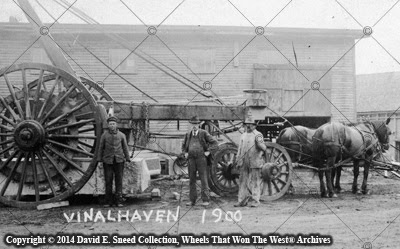Several folks have asked us, “What’sthat vehicle shown on the introductory page in Volume One of your “Borrowed Time” book? Great question. It’s a set of wheels more particularly knownto those in the northeastern part of the U.S - Specifically, the legendarygranite quarries on the islands of Vinalhaven, Maine. The vehicle is called a Galamander(pronunciation rhymes with ‘salamander’). While the name is certainly memorable, its origins aren’t quite asclear. Nevertheless, the design of thegiant machine made it possible for 19th century artisans and contractors tocreate some of the most stylish and impressive buildings, bridges, dams, lighthouses,monuments - even paving blocks - in major metropolitan areas like Boston, NewYork, Philadelphia, Washington D.C., Chicago, St. Louis, Portland, andcountless other leading cities. As anexample, the Washington Monument in the U.S. Capitol includes stones originallycarried by these Galamanders.
Similar to the “Big Wheels” (read more about these on our website)that were used to carry large timber out of forests, the oversized nature ofthese stone-hauling behemoths is a reflection of the duties they wereengineered to tackle. Rear wheels onthese innovative wagons could measure as much as 12 feet in diameter. (As big as the Giant Moline wagon wediscussed in last week’s blog was, many of these Galamanders would have dwarfedthe purely promotional intentions of the Moline!) Just to move the granite stones oftenrequired an eight horse hitch. Outfittedwith a rope tackle and large levered derrick, the granite could be hoisted upbelow the vehicle and between the rear wheels. Horse teams were then able to transfer otherwise immovable tons of solidgranite blocks to the cutting yards and polishing mills.
Well over a century ago, theseGalamanders were a common sight in Vinalhaven. Crawling throughout the quarries, shipping port, and parts in between,their beefy skeletal frames can seem like something straight out of sciencefiction. Unfortunately, time, weather,and inattention have destroyed almost all of these legendary leviathans. Today, the Vinalhaven Historical Society hasonly one survivor on display. With agranite mining history dating to the mid-1820’s, both Vinalhaven and theGalamander stand as a testimony to a time when the legacy of America was drivenby dreams and carved in stone. You'll want to stay in touch this year as we have a healthy lineup of great subjects to cover. So... If you haven’t signed up toreceive this weekly blog via email and don't want to miss anything, you may want to type in your address in the “Follow By Email” section above. You’ll receive a confirmation email that you’ll need to verify before you’reofficially on board. Please don’t hesitate to let us know if we can be ofassistance. We’re looking forward to your visits each week.

